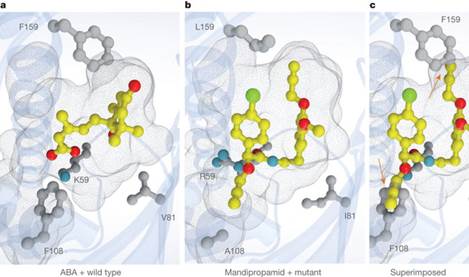科学家改编植物抗旱性
导读:植物生物学家发现,可以工程改编植物,使其在响应某已用农化品时激活其保水反应,从而提高植物的抗旱性——该法可广泛应用于同一干旱-响应途径的其他部分和一系列其他农化品。这个发现说明了合成生物学方法操控作物及为作物改良开辟新途径的能力。


农作物和其他植物持续面临着不利的环境条件,如逐渐升高的温度(2014是记录以来最热的年份)和不断减少的淡水供应,继而降低产量,令农民每年损失数十亿美元。
干旱是影响植物生长和发育的主要环境胁迫因子。当植物遇到干旱,自然地产生应激激素脱落酸(ABA),抑制植物生长并降低水份消耗。具体而言,当植物中的激素像手进入手套一样紧密接触受体(特殊的蛋白质)时,会打开受体,引起有益的变化——例如关闭叶片气孔的保卫细胞以减少水的损失——帮助植物生存。
虽然确实可以喷洒ABA帮助作物在干旱时存活,但因ABA造价昂贵、在植物细胞中迅速失活、光敏性强,未能在农业中直接使用。几个研究团队正致力于合成ABA仿制品来调节耐旱,但发现的这些仿制品都将面临漫长而昂贵的开发过程。
然而,农化品双炔酰菌胺已经广泛应用于农业生产中控制水果和蔬菜晚疫病。那么,能工程改编受到干旱胁迫的作物使其响应双炔酰菌胺,就像响应ABA一样提高作物抗旱性吗?
根据加州大学河滨分校科学家Sean Cutler团队的研究,答案是肯定的。
研究人员以广泛应用于植物生物学实验室的模式植物拟南芥和番茄为研究对象。他们利用合成生物学方法开发了一个这些植物脱落酸受体的新版本,重编程使其由双炔酰菌胺而非ABA激活。研究表明,当重组植物喷洒双炔酰菌胺时,植物成功地打开了脱落酸途径,关闭叶片气孔防止水分流失,经受住了干旱条件。
加州大学河滨分校的合成生物研究“重编程植物暴露于农化品后减少水分消耗”提供了一个策略,为作物改良开辟了新的途径。(编译:中国科学院成都生物研究所 王芋华,王海燕)
Agrochemical control of plant water use using engineered abscisic acid receptors
Abstract Rising temperatures and lessening fresh water supplies are threatening agricultural productivity and have motivated efforts to improve plant water use and drought tolerance. During water deficit, plants produce elevated levels of abscisic acid (ABA), which improves water consumption and stress tolerance by controlling guard cell aperture and other protective responses1, 2. One attractive strategy for controlling water use is to develop compounds that activate ABA receptors, but agonists approved for use have yet to be developed. In principle, an engineered ABA receptor that can be activated by an existing agrochemical could achieve this goal. Here we describe a variant of the ABA receptor PYRABACTIN RESISTANCE 1 (PYR1) that possesses nanomolar sensitivity to the agrochemical mandipropamid and demonstrate its efficacy for controlling ABA responses and drought tolerance in transgenic plants. Furthermore, crystallographic studies provide a mechanistic basis for its activity and demonstrate the relative ease with which the PYR1 ligand-binding pocket can be altered to accommodate new ligands. Thus, we have successfully repurposed an agrochemical for a new application using receptor engineering. We anticipate that this strategy will be applied to other plant receptors and represents a new avenue for crop improvement.
原文链接:http://www.nature.com/nature/journal/vaop/ncurrent/pdf/nature14123.pdf

